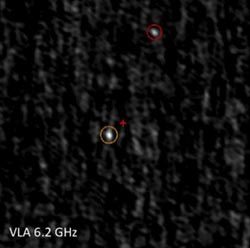MSU-led research finds another black hole in a star cluster

This an image of globular cluster M62 captured by a radio telescope. The star-like object within the orange circle is believed to be a black hole discovered by a team of researchers led by an MSU astronomer. Photo courtesy of the National Radio Astronomy Observatory.<br>
Researchers are now thinking it was the former, as evidence of yet another black hole has been found in a globular cluster by an MSU-led team of researchers.
As published in the recent issue of Astrophysical Journal, a new black hole candidate has been found in a globular cluster known as M62.
“This implies that the discovery of the other black hole, in the globular cluster called M22, was not just a fluke,” said Laura Chomiuk, team member and MSU assistant professor of physics and astronomy. “Black holes really may be common in globular clusters.”
Black holes are stars that have died, collapsed into themselves and now have such a strong gravitational field that not even light can escape from them.
The globular cluster M62 is located in the constellation Ophiuchus, about 22,000 light years from Earth.
Until recently, astronomers had assumed that the black holes did not occur in globular clusters, which are some of the oldest and densest collections of stars in the universe. Stars are packed together a million times more closely than in the neighborhood of our sun.
There are so many stars in such a condensed area that they often interact with one another. Massive black holes would have the most violent encounters, “sling-shotting” each other out of the cluster.
Last year’s discovery of a pair of black holes in a cluster was especially surprising, Chomiuk said. It had been thought that if two black holes dwelled at the center, they would regularly encounter one another until one shoved the other out.
“I think it’s safe to say that we have discovered a whole new hunting ground for black holes,” said Chomiuk.
This latest discovery was made by using the National Science Foundation’s Karl G. Jansky Very Large Array telescope in New Mexico.
To view the paper, visit http://iopscience.iop.org/0004-637X/777/1/69/article.
Media Contact
More Information:
http://www.msu.eduAll latest news from the category: Physics and Astronomy
This area deals with the fundamental laws and building blocks of nature and how they interact, the properties and the behavior of matter, and research into space and time and their structures.
innovations-report provides in-depth reports and articles on subjects such as astrophysics, laser technologies, nuclear, quantum, particle and solid-state physics, nanotechnologies, planetary research and findings (Mars, Venus) and developments related to the Hubble Telescope.
Newest articles

A universal framework for spatial biology
SpatialData is a freely accessible tool to unify and integrate data from different omics technologies accounting for spatial information, which can provide holistic insights into health and disease. Biological processes…

How complex biological processes arise
A $20 million grant from the U.S. National Science Foundation (NSF) will support the establishment and operation of the National Synthesis Center for Emergence in the Molecular and Cellular Sciences (NCEMS) at…

Airborne single-photon lidar system achieves high-resolution 3D imaging
Compact, low-power system opens doors for photon-efficient drone and satellite-based environmental monitoring and mapping. Researchers have developed a compact and lightweight single-photon airborne lidar system that can acquire high-resolution 3D…





















